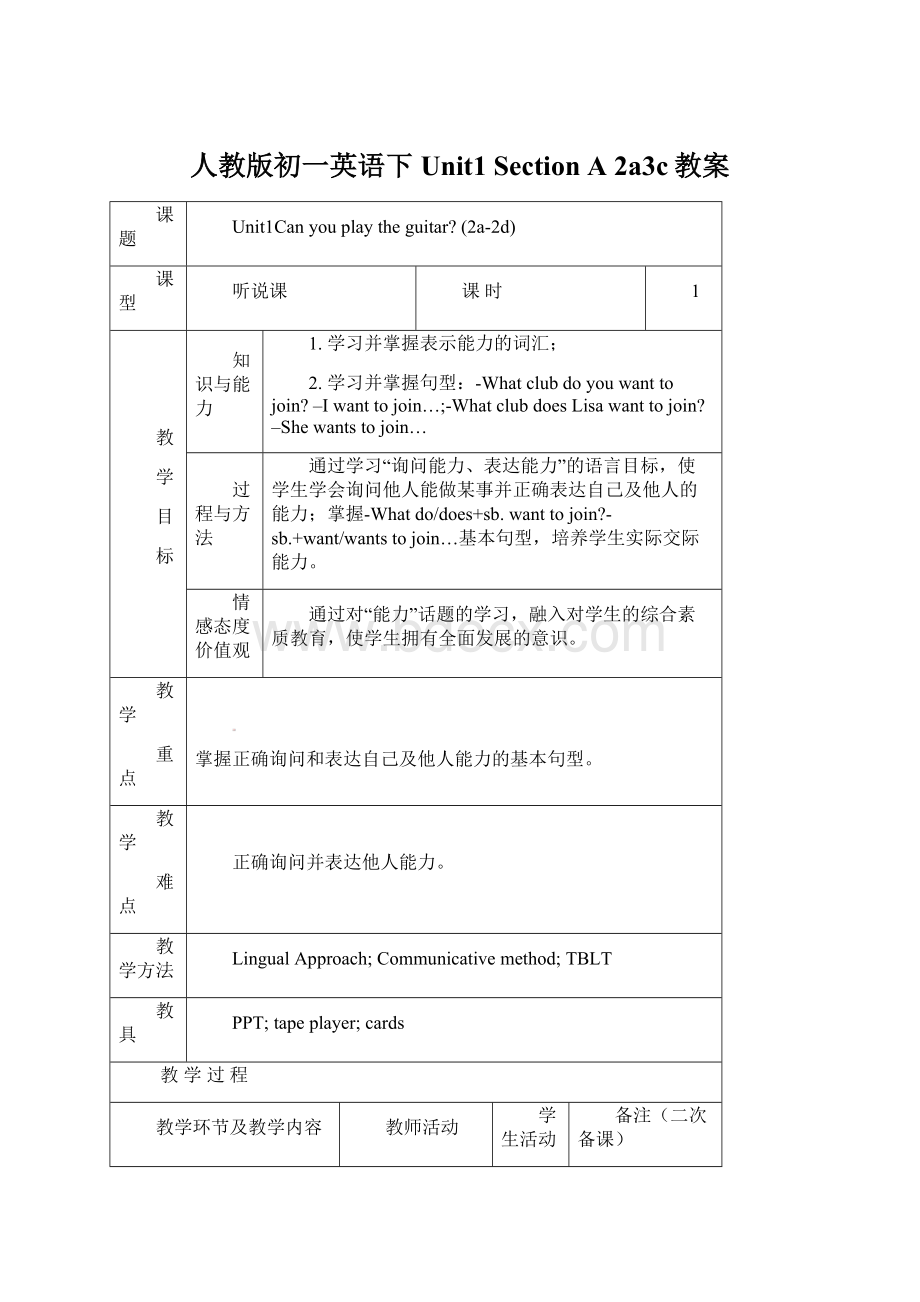人教版初一英语下Unit1Section A2a3c教案Word格式.docx
《人教版初一英语下Unit1Section A2a3c教案Word格式.docx》由会员分享,可在线阅读,更多相关《人教版初一英语下Unit1Section A2a3c教案Word格式.docx(10页珍藏版)》请在冰豆网上搜索。

通过对“能力”话题的学习,融入对学生的综合素质教育,使学生拥有全面发展的意识。
教学
重点
掌握正确询问和表达自己及他人能力的基本句型。
难点
正确询问并表达他人能力。
教学方法
LingualApproach;
Communicativemethod;
TBLT
教具
PPT;
tapeplayer;
cards
教学过程
教学环节及教学内容
教师活动
学生活动
备注(二次备课)
StepIWarming-up
Showsomepicturesaboutschoolcommunities.
Havealookatthepictures.
StepII
Presentation
StepIII
Listening&
Speaking
1.Directsubject,interpretcurriculum,analysisofthetarget.
2.AskSstosumupdifferentclubsasmanyaspossible.
1.Playthetapeforthefirsttime.
Practicesentencepatten.
2.Showthelisteningmaterialwithblanks.
3.Playthetapeforthethirdtime.
1.Understandingoflearningrequirements.
2.Brainstorm.
1.Circletheclubs.
Askandanswer.
2.Fillintheblankswhilelistening.
3.Listenagain.Completethesentences.
StepIV
Production
StepV
Summary
StepVI
Homework&
Emotioneducation
1.Playthetape.
Explainthekeys.
2.LeadSstoreadbythemselvesandgivethemtwoquestionstoanswer.
3.AskSstocompletethechartwhilereadingforthesecondtime.
Howtotalkaboutwhatthepeoplecandoandtheclubstheywanttojoin.
Dreamsarehardtofollow,butdon’tletanyonetearthemdown.
1.Underlinethekeyswhilelistening.
2.Readtheconversationandanswerquestions.
3.Completethechart.
Sumuptogetherwiththeteacher.
板
书
设
计
Unit1Canyouplaytheguitar?
SectionA(2a-2d)
begoodat-Whatclubdoyouwanttojoin?
tell-Iwanttojointhe...club
story-Whatclubdoeshe/shewanttojoin?
-He/Shewantstojointhe...
反
思
Unit1SectionA(2d-3c)教案
1.0Teachinganalysis教情分析
1.1Teachingobjectives教学目标
1.1.1Languagegoals语言目标
1.1.1.1KeyWordsandChunks
1.1.1.1.1Forapplying:
tell,story,write,show,or,talk,
begoodat,tellstories,talkto
1.1.1.1.2Forcomprehending:
kungfu,dokungfu,storytellingclub
1.1.1.2SentenceStructures
1.1.1.2.1Forapplying:
1)Whatclubdoyouwanttojoin?
2)Iwanttojoinasportsclub.
3)You’reverygoodattellingstories.
4)Youcanjointhestorytellingclub.
5)Iliketodraw,too.
6)Let’sjoinnow.
1.1.1.2.2Forcomprehending:
1)Studentswantedforschoolshow.
2)Wewantstudentsfortheschoolshow.
1.1.1.3GrammarFocus
1)Canheplaychess?
Yes,hecan./No,hecan’t.(can的一般疑问句不需要加助动词,没有人称和数的变化,回答时肯定回答用can,否定回答用can’t。
)
2)CanyouandTomplaychess?
Yes,wecan./No,wecan’t.(把you和别人一起用时,you放在前面,回答问题时,用we做主语。
3)Whatclubdoyouwanttojoin?
Wewanttojointhechessclub.(want之后跟动词用不定式,“参加”社团、兴趣小组等组织时用join,“参加”某项活动用joinin或takepartin.)
1.1.2Abilitygoals能力目标
1.1.2.1通过课本提供的对话学习,学生能够在给定的话题背景下使用目标语言“Whatcanyoudo?
”and“Whatclubdoyouwanttojoin?
”。
1.1.2.2通过对话学习,学会使用一些重点单词和短语。
1.1.2.3在教师启发下,通过小组合作学习,学生能够总结梳理出情态动词can的用法和实意动词want后跟动词不定式的用法。
1.1.3Emotionalgoals情感目标
1.1.3.1通过对第一课时话题的复习和本课时对话的学习,让学生认识到学校各种社团活动的重要性。
1.1.3.2鼓励学生积极参加各种学校社团活动以展示自己的才能。
1.1.3.3鼓励学生发展自己的爱好来丰富学校生活。
1.2Importantanddifficultteachingpoints教学重难点
1.2.1学生在教师引导和同伴互助下能够总结梳理出情态动词can的用法。
1.2.2学生能够运用目标句型来表达自己的想法。
1.2.3学生能够仿照课本范例写出自己的活动招募海报。
2.0Studentanalysis学情分析
2.1FundamentalState基本情况
通过本单元第一课时的学习,学生基本上激活了已有的语言知识,对本单元的话题(Joiningaclub)已经有所感知,对情态动词can的基本用法有了初步的认识;
词汇的学习和基础句型的听说活动,为本课时的对话练习和语法现象的归纳,进行了很好的铺垫。
同时,通过视频观看和教师的激励,学生的自信心(IbelieveIcan.)和学习动机增强了。
2.2KnowledgeReserve知识储备
第一课时的学习,围绕本单元话题Joiningaclub,呈现了相关词汇如sing,swim,dance,draw,playchess等动词和themusicclub,theartclub等名词性短语,对本单元核心句型Iwanttojointhe...club.和Ican...进行了听和说的练习,为本节课的对话表演和语法归纳积累了语言基础。
2.3ClassData本班实际
通过7年级上学期的小组建设和小组合作学习的训练,本班学生有比较明确的小组合作学习的意识,小组内开展活动有分工合作,能倾听别人意见,敢于用英语来表达自己的观点。
虽然本课时的语言现象学生在学习本单元之前基本上没有接触,但是涉及的话题与学生学校生活密切相关(基本上所有学校都有人文、科学、体育艺术之类的学生非常感兴趣的社团活动),因此,完成本课时任务是应该没有太大的困难的。
教师可结合课堂实际情况,指导学生有感情地模仿对话语音语调,引导学生归纳相关的语法现象,从而实现方法的掌握和能力的提升。
3.0Teachingmethods教法建议
3.1Thematicteachingmethod主题教学法
3.2Self-directedlearningmethod自主学习法
3.3Discussionmethod讨论法
4.0教学辅助
blackboardandchalk,computer,projector
5.0Teachingprocedures教学进程
5.1Leading-inandwarming-up引入与激趣活动
5.1.1Inordertoleadinthemaintopic,TcangetSstolistentoanEnglishsongIbelieveIcanfly.Thenask:
Q1.Howdoyoufeelwhenyoulistentothissong?
Q2.WhatcanyoulearnfromEnglishsongs?
Q3.DoyoulikelisteningtoEnglishsongs?
Canyousingalittle?
5.1.2Showsomepicturesofdifferentschoolclubs(basketballclub,pingpongclub,artclub,musicclub,swimclub)andgetSstotalkaboutthem.AskSsquestionslike:
T:
Whataretheydoinginthispicture?
Ss:
They’replayingbasketball.
Doyouliketoplaybasketball?
S1:
Yes,Ido.
Doyouwanttojointhebasketballclub?
Yes.ThenIcanoftenplaybasketball.
5.1.3GettheSstotalkaboutthepicturesinpairs.TheymayfollowtheconversationbetweenTandS1.
5.2Role-playtheconversation对话表演
5.2.1Beforerole-playing
5.2.1.1
Playtherecordingof2donP2forSstolistenforthemainidea.Beforeplayingtherecording,TwritesthefollowingquestionsontheBb.
Q1.WhatareBobandJanetalkingabout?
(They’retalkingaboutjoiningschoolclubs.)
Q2.WhatsportscanBobplay?
(Hecanplaysoccer.)
5.2.1.2
GetSstoreadtheconversationandanswermorequestions.Thistime,Tneedn’twritethequestionsontheBb.
Q1.What’sJanegoodatdoing?
Q2.DoesJanelikedrawing?
Q3.Whatclubmightshejoin?
Checktheanswerswiththewholeclass.Tmaygivenecessaryexplanationsatthisstage.
5.2.2Listeningandimitating
Playtherecording2or3timesforSstolistenandimitate.
5.2.3Role-playing
5.2.3.1GetSstoworkinpairstogetreadytoactouttheconversationin2d.WhileSsarepreparingforthis,Tmaywalkaroundtooffernecessaryhelp.
5.2.3.2SomeSsmayhaveproblemswiththepronunciationsofsomeofthenewwords.Othersmaynotbe“role-playingtheconversation”.Theymightjustbe“reading”or“reciting”theconversation.ThenTmayshowthemhowto“role-play”aconversation:
theyneedtolookattheotherpersonwhilespeakingtohim/her.
5.2.3.3ChoosesomepairstoactouttheconversationandasktheotherSstotellwhichpairisthebest
5.2.4Afterrole-playing
AfterpairsofSsrope-playtheconversation,TmayputthefollowingpassageontheBboronthescreenandgetSstofillintheblanksaccordingtotheconversation.
JaneandBobaretalkingaboutjoiningdifferentclubs.Bobcan________soccer,________hecan________thesoccerclub.Janeisgoodat_________________,soshecanjointhestorytellingclub.Andshealsolikesto________.Maybeshecanjoin________clubs,thestorytellingclubandtheartclub.
5.3Newpointsinterpretation新知感悟(贴标签)
5.3.1Discoveringchunks语块发现
GetSstoreadtheconversationonceagain,andunderlinealltheusefulchunksinit.
5.3.2Analyzingchunks语块分析
5.3.2.1Iwanttojoinasportsclub.我想加入一个体育运动的社团。
动词want之后可以接名词,如:
Iwantanapple.
接动词时常用动词不定式。
如:
Iwanttohaveanapple.
“参加”社团、兴趣小组等组织或者一群人时用join.如:
Doyouwanttojoinus?
“参加”某项活动时通常用joinin或takepartin.如:
Marywantstotakepartin/joinintheschoolshow.
5.3.2.2.You’reverygoodattellingstories.你很会讲故事。
begoodat后接名词、代词或动词的-ing形式等名词性短语,表示“擅长于某个方面”或“擅长做某事”,可与dowellin等结构转换。
本句可以替换为Youdoverywellintellingstories.又如:
Mikeplaysbasketballwell.=Mikeisgoodatplayingbasketball.=Mikedoeswellinplayingbasketball.=Mikeisagoodbasketballplayer.
“讲故事”用tellstories,“说英语”用speakEnglish,“与人交谈”talkto/withsb.,后接“说的具体内容时”用saysth.。
5.3.3Usingchunks语块运用
GuideSstoknowthemeaningsofthefollowingsentencesandmakesimilarnewsentencesoftheirown.AndgetsomeSstosharetheiroriginalsentences.
5.3.3.1
Whatclubdoyouwanttojoin?
(P2)
【原句翻译】_____________________________________________________________________
【仿写造句】Whatclub...wanttojoin?
__________________________________________________________________
5.3.3.2
Youcanjointhestorytellingclub.(P2)
【仿写造句】join...club
______________________________________________________________________
5.3.3.3
Let’sjoinnow.(P2)
【仿写造句】Let’sdo…
5.3.4FindingGrammarRules发现语法规律
5.3.4.1Groupwork.SsworkingroupstostudythesentencesinGrammarFocusonP3.Tmayleavesomequestionsforthemtodiscuss:
1)情态动词can后的动词形式有什么特点?
有第三人称单数吗?
2)情态动词can本身随人称变化而变化吗?
3)情态动词can的否定形式是什么样的?
一般疑问句形式又是什么样的?
需要借助do或does这样的助动词吗?
TmaygetSsfromdifferentgroupstotellwhattheyknowabouttheuseofthemodalverbcan,andgivenecessaryexplanations.
TmayexplaininChineselikethis:
1)情态动词can后接动词原形(不能用第三人称单数形式,不能用to+动词原形或者-ing形式);
2)情态动词can没有人称和数的变化,不能在它后面加“-s”,它也没有-ing形式;
3)情态动词can的意思是“能够,可以”,表示能力或允许,它的否定形式是can’t或cannot,否定句和疑问句都不需要加do,does之类的助动词。
5.3.4.2Ssreadandtrytolearnthesentencesbyheart.
5.3.4.3Ssdo3aand3bontheirown.Thenchecktheanswersintheirgroups.Tmayoffernecessaryhelp.
5.4PracticeandConsolidation练习与巩固